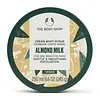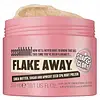What's inside
What's inside
 Key Ingredients
Key Ingredients

 Benefits
Benefits

 Concerns
Concerns

 Ingredients Side-by-side
Ingredients Side-by-side

Water
Skin ConditioningGlycine Soja Oil
EmollientGlycerin
HumectantPolyglyceryl-3 Distearate
EmulsifyingCetearyl Alcohol
EmollientSesamum Indicum Seed Oil
EmollientHydrated Silica
AbrasiveHydrogenated Jojoba Oil
AbrasiveCetyl Alcohol
EmollientParfum
MaskingButyrospermum Parkii Butter
Skin ConditioningOrbignya Oleifera Seed Oil
EmollientBis-Diglyceryl Polyacyladipate-2
EmollientPhenoxyethanol
PreservativeCaprylyl Glycol
EmollientSodium Stearoyl Glutamate
CleansingJuglans Regia Shell Powder
AbrasiveAcrylates/C10-30 Alkyl Acrylate Crosspolymer
Emulsion StabilisingPrunus Amygdalus Dulcis Shell Powder
AbrasiveGlyceryl Stearate Citrate
EmollientTrisodium Ethylenediamine Disuccinate
Sodium Hydroxide
BufferingTocopherol
AntioxidantPrunus Amygdalus Dulcis Seed Extract
Skin ConditioningDenatonium Benzoate
MaskingXanthan Gum
EmulsifyingBenzyl Alcohol
PerfumingCitric Acid
BufferingDehydroacetic Acid
PreservativeCI 19140
Cosmetic ColorantWater, Glycine Soja Oil, Glycerin, Polyglyceryl-3 Distearate, Cetearyl Alcohol, Sesamum Indicum Seed Oil, Hydrated Silica, Hydrogenated Jojoba Oil, Cetyl Alcohol, Parfum, Butyrospermum Parkii Butter, Orbignya Oleifera Seed Oil, Bis-Diglyceryl Polyacyladipate-2, Phenoxyethanol, Caprylyl Glycol, Sodium Stearoyl Glutamate, Juglans Regia Shell Powder, Acrylates/C10-30 Alkyl Acrylate Crosspolymer, Prunus Amygdalus Dulcis Shell Powder, Glyceryl Stearate Citrate, Trisodium Ethylenediamine Disuccinate, Sodium Hydroxide, Tocopherol, Prunus Amygdalus Dulcis Seed Extract, Denatonium Benzoate, Xanthan Gum, Benzyl Alcohol, Citric Acid, Dehydroacetic Acid, CI 19140
Glycerin
HumectantSodium Chloride
MaskingCaprylic/Capric Triglyceride
MaskingMaris Sal
Skin ConditioningSucrose
HumectantGlyceryl Stearate
EmollientPolysorbate 20
EmulsifyingPEG-100 Stearate
Parfum
MaskingPrunus Persica Seed Powder
AbrasiveVitis Vinifera Seed Oil
EmollientButyrospermum Parkii Butter
Skin ConditioningPrunus Amygdalus Dulcis Oil
Skin ConditioningDipropylene Glycol
HumectantHexyl Cinnamal
PerfumingLimonene
PerfumingButylphenyl Methylpropional
PerfumingBenzyl Salicylate
PerfumingLinalool
PerfumingBHT
AntioxidantGeraniol
PerfumingAlpha-Isomethyl Ionone
PerfumingGlycerin, Sodium Chloride, Caprylic/Capric Triglyceride, Maris Sal, Sucrose, Glyceryl Stearate, Polysorbate 20, PEG-100 Stearate, Parfum, Prunus Persica Seed Powder, Vitis Vinifera Seed Oil, Butyrospermum Parkii Butter, Prunus Amygdalus Dulcis Oil, Dipropylene Glycol, Hexyl Cinnamal, Limonene, Butylphenyl Methylpropional, Benzyl Salicylate, Linalool, BHT, Geraniol, Alpha-Isomethyl Ionone
Ingredients Explained
These ingredients are found in both products.
Ingredients higher up in an ingredient list are typically present in a larger amount.
This ingredient is also known as shea butter. It is an effective skin hydrator and emollient.
Emollients help soothe and soften your skin. It does this by creating a protective film on your skin. This barrier helps trap moisture and keeps your skin hydrated. Emollients may be effective at treating dry or itchy skin.
Shea butter is rich in antioxidants. Antioxidants help fight free-radicals, or molecules that may harm the body. It is also full of fatty acids including stearic acid and linoleic acid. These acids help replenish the skin and keep skin moisturized.
While Shea Butter has an SPF rating of about 3-4, it is not a sunscreen replacement.
Shea butter may not be fungal acne safe. We recommend speaking with a professional if you have any concerns.
Learn more about Butyrospermum Parkii ButterGlycerin is already naturally found in your skin. It helps moisturize and protect your skin.
A study from 2016 found glycerin to be more effective as a humectant than AHAs and hyaluronic acid.
As a humectant, it helps the skin stay hydrated by pulling moisture to your skin. The low molecular weight of glycerin allows it to pull moisture into the deeper layers of your skin.
Hydrated skin improves your skin barrier; Your skin barrier helps protect against irritants and bacteria.
Glycerin has also been found to have antimicrobial and antiviral properties. Due to these properties, glycerin is often used in wound and burn treatments.
In cosmetics, glycerin is usually derived from plants such as soybean or palm. However, it can also be sourced from animals, such as tallow or animal fat.
This ingredient is organic, colorless, odorless, and non-toxic.
Glycerin is the name for this ingredient in American English. British English uses Glycerol/Glycerine.
Learn more about GlycerinParfum is a catch-all term for an ingredient or more that is used to give a scent to products.
Also called "fragrance", this ingredient can be a blend of hundreds of chemicals or plant oils. This means every product with "fragrance" or "parfum" in the ingredients list is a different mixture.
For instance, Habanolide is a proprietary trade name for a specific aroma chemical. When used as a fragrance ingredient in cosmetics, most aroma chemicals fall under the broad labeling category of “FRAGRANCE” or “PARFUM” according to EU and US regulations.
The term 'parfum' or 'fragrance' is not regulated in many countries. In many cases, it is up to the brand to define this term.
For instance, many brands choose to label themselves as "fragrance-free" because they are not using synthetic fragrances. However, their products may still contain ingredients such as essential oils that are considered a fragrance by INCI standards.
One example is Calendula flower extract. Calendula is an essential oil that still imparts a scent or 'fragrance'.
Depending on the blend, the ingredients in the mixture can cause allergies and sensitivities on the skin. Some ingredients that are known EU allergens include linalool and citronellol.
Parfum can also be used to mask or cover an unpleasant scent.
The bottom line is: not all fragrances/parfum/ingredients are created equally. If you are worried about fragrances, we recommend taking a closer look at an ingredient. And of course, we always recommend speaking with a professional.
Learn more about Parfum